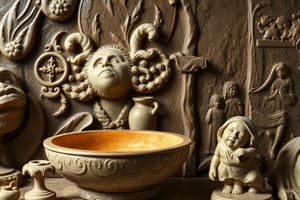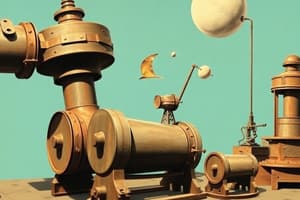Podcast
Questions and Answers
What is the machining allowance for all surfaces as specified?
What is the machining allowance for all surfaces as specified?
- 2 mm
- 1 mm
- 5 mm
- 3 mm (correct)
What is the final dimension at the top after applying the draft allowance of 0.75°?
What is the final dimension at the top after applying the draft allowance of 0.75°?
- 211.00 mm
- 210.60 mm
- 213.80 mm (correct)
- 212.40 mm
What is a core used for in the casting process?
What is a core used for in the casting process?
- To enhance the surface finish
- To obtain holes or internal cavities (correct)
- To make the casting heavier
- To provide additional strength to the mould
Which material property must chaplets possess for effective support of large cores?
Which material property must chaplets possess for effective support of large cores?
Which characteristic is NOT required for the cores used in casting?
Which characteristic is NOT required for the cores used in casting?
What is the purpose of the pouring basin in a gating system?
What is the purpose of the pouring basin in a gating system?
Which component of the gating system is specifically designed to reduce the momentum of molten metal?
Which component of the gating system is specifically designed to reduce the momentum of molten metal?
What role does the runner play in a gating system?
What role does the runner play in a gating system?
Which component functions as the passage for molten metal to enter the mould cavity?
Which component functions as the passage for molten metal to enter the mould cavity?
What is the purpose of a gate in a gating system?
What is the purpose of a gate in a gating system?
What is the primary function of the sprue base in a casting system?
What is the primary function of the sprue base in a casting system?
Which of the following terms is NOT associated with the characteristics of a sprue?
Which of the following terms is NOT associated with the characteristics of a sprue?
What does the volume flow rate (Q) depend on in the context of a sprue?
What does the volume flow rate (Q) depend on in the context of a sprue?
What is the effect of a tapered sprue compared to a straight sprue?
What is the effect of a tapered sprue compared to a straight sprue?
In a casting system, which component directly regulates the flow of molten metal into the mold?
In a casting system, which component directly regulates the flow of molten metal into the mold?
What is the primary purpose of a pouring basin in metal pouring?
What is the primary purpose of a pouring basin in metal pouring?
What role does a ceramic strainer play in the sprue during metal pouring?
What role does a ceramic strainer play in the sprue during metal pouring?
How does a splash core assist in the pouring process?
How does a splash core assist in the pouring process?
What is the main function of a skimmer placed in a horizontal gate?
What is the main function of a skimmer placed in a horizontal gate?
According to Bernoulli’s theorem, what does the term 'head' represent?
According to Bernoulli’s theorem, what does the term 'head' represent?
If point 2 is used as the reference plane in a pouring system, what is the head at that point?
If point 2 is used as the reference plane in a pouring system, what is the head at that point?
What condition is assumed throughout a typical pouring system as highlighted in the content?
What condition is assumed throughout a typical pouring system as highlighted in the content?
What is the initial velocity of the liquid metal at the top of the sprue?
What is the initial velocity of the liquid metal at the top of the sprue?
What is the purpose of a pattern in the sand casting process?
What is the purpose of a pattern in the sand casting process?
Which of the following statements best describes when casting is most suitable?
Which of the following statements best describes when casting is most suitable?
What is a significant disadvantage of using wooden patterns?
What is a significant disadvantage of using wooden patterns?
Which metal is commonly used for making patterns due to its advantages in casting?
Which metal is commonly used for making patterns due to its advantages in casting?
What is one of the economic advantages of casting compared to other manufacturing processes?
What is one of the economic advantages of casting compared to other manufacturing processes?
What is a common rationale for selecting metal patterns over wooden patterns?
What is a common rationale for selecting metal patterns over wooden patterns?
What are cores used for in the sand casting process?
What are cores used for in the sand casting process?
What is one limitation associated with using metal patterns?
What is one limitation associated with using metal patterns?
Flashcards are hidden until you start studying
Study Notes
Casting Processes: Necessity and Overview
- Casting is crucial for creating large, single-piece parts and complex shapes with internal cavities.
- It's economically advantageous and suitable for materials difficult to process otherwise.
- The sand casting process uses a disposable sand mold to create the desired shape. The process is relatable to key duplication.
Sand Casting: Pattern Making
- Patterns are replicas of the desired casting, used to create impressions in the sand mold.
- They require modifications like allowances for machining and core prints.
- Materials include wood (suitable for small quantities and large castings, but susceptible to moisture), metal (for mass production, high wear resistance, and tighter tolerances; aluminum is a common choice), and plastic.
Pattern Making: Material Considerations
- Wood: Readily available, lightweight, inexpensive, but absorbs moisture, has a short lifespan, and dimensional changes.
- Metal: Durable, maintains tighter dimensional tolerances, longer lifespan, but heavier (copper, steel) and prone to corrosion. Aluminum is frequently used for its balance of properties.
- Machining allowance is typically 3 mm per surface. Example: A 100mm dimension requires a 106mm pattern.
Draft Allowance
- Draft allowance is included in pattern dimensions to facilitate easy removal from the sand mold.
- Example: A 0.75° draft angle applied to a 109mm external detail adds approximately 1.40mm per side.
Cores
- Cores create internal cavities or holes that aren't part of the main pattern.
- They are produced separately and baked for strength.
- They're placed in core prints within the mold; sand, metal, or ceramics are used.
- Core properties include strength, erosion resistance, permeability to gases, high refractoriness, and a good surface finish.
Chaplets
- Large cores may need additional support provided by chaplets (rigid metal pieces) placed between the core and mold face.
- Chaplet material needs to be compatible with the molten metal.
Gating System
- The gating system channels molten metal into the mold cavity, preventing erosion of the mold bottom.
- Components include: pouring basin, sprue, sprue well, runner, gates, and riser.
- A tapered sprue reduces the momentum of molten metal, minimizing turbulence.
Gating System Components and Functions
- Pouring Basin: Reduces the force of the molten metal stream.
- Sprue: The main vertical channel. A tapered sprue helps regulate flow.
- Sprue Base: Reservoir at the bottom of the sprue to moderate the flow.
- Runner: Horizontal channel distributing molten metal.
- Gate: Smaller channels leading directly into the mold cavity.
- Riser: Reservoir supplying molten metal to compensate for shrinkage during solidification.
Preventing Impurities
- Pouring basins reduce erosion.
- Strainers remove dross (impurities).
- Splash cores reduce turbulence.
- Skim bobs trap heavier and lighter impurities in horizontal gates.
Engineering Analysis of Pouring: Bernoulli's Theorem
-
Bernoulli's theorem, considering atmospheric pressure, relates head (height), pressure, and velocity of flowing liquid. The sum of these energies remains constant between two points in the fluid (friction losses are ignored).
-
In the context of the sprue, the height of the sprue contributes head, while the velocity differences at top and bottom effect the pressure. The initial velocity at the top of the sprue is assumed zero.
Studying That Suits You
Use AI to generate personalized quizzes and flashcards to suit your learning preferences.



